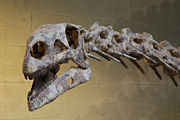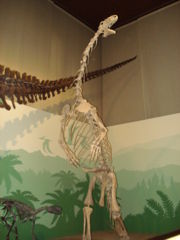Plateosaurus
2008/9 Schools Wikipedia Selection. Related subjects: Dinosaurs
| Plateosaurus Fossil range: Late Triassic |
||||||||||||||||||
|---|---|---|---|---|---|---|---|---|---|---|---|---|---|---|---|---|---|---|
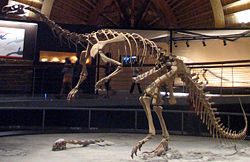 Plateosaurus at the Museo del Jurásico de Asturias.
|
||||||||||||||||||
| Scientific classification | ||||||||||||||||||
|
||||||||||||||||||
| Species | ||||||||||||||||||
|
||||||||||||||||||
| Synonyms | ||||||||||||||||||
|
Plateosaurus (meaning 'flat lizard') is a genus of plateosaurid prosauropod dinosaur that lived during the Norian and Rhaetian stages of the Late Triassic period, around 216 to 199 million years ago in what is now Europe. There are two currently recognized species, P. engelhardti and P. longiceps, although others have been assigned in the past.
Discovered in 1834 and described three years later, Plateosaurus was one of the first dinosaurs formally named, although not one of the three genera originally used to define Dinosauria, because at the time it was poorly known and impossible to identify as a dinosaur. Plateosaurus were bulky bipedal herbivores which had small skulls on long necks, sharp plant-crushing teeth, powerful limbs, and large thumb claw on each ' hand' probably used for defense and feeding.
Description
Plateosaurus was the largest known dinosaur of its time, reaching 6 to 10 meters in length and up to an estimated 700 kg in mass. A member of the group of early herbivores known as prosauropods, it was more powerfully built than that of similar animals such as Anchisaurus. Plateosaurus had a long neck, composed of around nine cervical vertebrae, a stocky body and a pear-shaped torso. It had a long tail composed of at least forty caudal vertebrae which served to counterbalance the front-heavy body and long neck.
The skull of Plateosaurus was deeper than that of Coelophysis — i.e. a stronger, deeper head than most prosauropods, although still small and narrow compared to the size of its body. It had four sets of fenestrae (skull openings); these openings were for the naris and orbit as well as an infratemporal fenestra at the back of the skull and an antorbital fenestra between the eye and nose. It had a long snout and many small, leaf-shaped, socketed teeth and the low-slung hinge of its lower jaw, which give the muscles greater leverage. These features suggest that it fed exclusively on plants. Its eyes were directed to the sides, rather than the front, providing all-round vision to watch for predators. Some fossil skeletons have preserved sclerotic rings.
Plateosaurus had numerous small teeth in both the upper and lower jaw, five to six on the premaxilla, twenty four to thirty on the maxilla, and twenty one to twenty eight on the dentary. These teeth had serrated, leaf-shaped crowns suitable for digestion of plant material. It is thought Plateosaurus had narrow cheek pouches which kept food from spilling out when it ate.
Discovery and history
In 1834, physician Johann Friedrich Engelhardt discovered some vertebrae and leg bones at Heroldsberg near Nuremberg, Germany. Three years later German palaeontologist Hermann von Meyer designated them as the type specimen of his new genus, Plateosaurus. This name is derived from the Greek words πλατυς/platys ('broad' or 'flat') which is derived as well from πλατη/platé ('flat surface'), and σαυρος ('lizard'), which refers to the animal's flat bones and reptilian nature. The type species was named in honour to its discoverer.
Between the 1910s and 1930s, excavations in a clay pit at Saxony-Anhalt dug up between 39 and 50 skeletons that belonged to Plateosaurus, Liliensternus and Halticosaurus. Some of this material was assigned to P. longiceps, which was described by paleontologist Otto Jaekel in 1914. At the same time, bonebeds at Trossingen revealed several remains of Plateosaurus, most of which were designated to species now dubious or invalid.
In 1997, workers of an oil platform of the Snorre oilfield located at the northern end of the North Sea, were drilling through sandstone for oil exploration when they stumbled upon a long cylinder of rock, drilled out at 2,256 meters below the seafloor. This cylinder contained a fossil which they believed was plant material. In 2003, the specimen was sent to Jørn Harald Hurum, paleontologist at the University of Oslo for study. After consulting paleontologists of the University of Bonn, they, with microscopic examination, concluded that the rock preserved fibrous bone tissue located within a crushed knucklebone which they identified as belonging to Plateosaurus, making it the first dinosaur found in Norway and the deepest in the world.
In August 2007, an amateur paleontologist unearthed a mass grave of dinosaurs near Frick, Switzerland, comprised of around 300 bones, in which two Plateosaurus individuals were discovered. Martin Sander, paleontologist at the University of Bonn, indicated the area could extend for 1.5 kilometers, making it the biggest fossil site in Europe. There is an estimate of one dinosaur per 100 square meters.
Classification
Plateosaurus was the first prosauropod to be described, and is the type genus of the family Plateosauridae, to which gives its name. At the beginning, when the genus was poorly known, it was only included in Sauria, with the possibility of being any kind of reptile. In 1845, Von Meyer created the group Pachypodes (now unused) to include Plateosaurus, Iguanodon, Megalosaurus and Hylaeosaurus, however, Dinosauria (technically the same as Pachypodes) already existed. Plateosauridae was proposed by Othniel Charles Marsh in 1895 within Theropoda. Years later, it was moved to Prosauropoda by Huene, and was accepted by most authors. For many years the clade only included Plateosaurus, but recently two more genera, Sellosaurus and possibly Unaysaurus, have been recognized.
Species
Valid and reassigned species
Only two of the many species assigned to this genus are still considered valid. P. engelhardti, the type species, is known from at least ten skulls and more than 100 fragmentary to complete skeletons, mainly from Bavaria, Germany. The second and best-known species, P. longiceps, is based on three of 50 specimens from the Knollenmergel site at Germany. P. longiceps differs from P. engelhardti in having a longer snout and limbs, with a much lighter body structure. A third species, P. gracilis lacks certain features of the genus Plateosaurus and has been placed in its own genus Sellosaurus. Other species like P. trossingensis, P. fraasianus and P. integer turned out to be synonyms of P. longiceps.
Dubious species
Several Plateosaurus species are considered to be nomina nuda ('naked names') or nomina dubia ('doubtful names') due to their fragmentary nature and poor preservation. Species like P. erlenbergiensis are difficult to determine because the holotype lacks the sacrum, ilium and proximal pubis, which are important bones in the comparison with well-known species.
Provenance
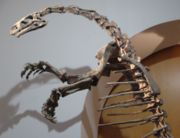
Plateosaurus is the best known of the prosauropods and one of the most common dinosaur fossils. More than 100 specimens and dozens of well-preserved skeletons have been unearthed in over 50 locations on Triassic sandstones all over western Europe. However the vast majority of fossil material belongs to P. longiceps, that unlike P. engelhardti (which is known only from Germany), has been found in more areas of Germany, France, Switzerland, and especially Greenland. It was thought that the specimens found at the Flemming Fjord Formation in Greenland belonged to P. engelhardti, but later the material was re-studied and shifted to P. longiceps.
Paleoecology
In some locations, groups of complete individual fossils have been found, indicating that herds traveled together through the Triassic arid desert-like landscape of Europe, searching for new feeding and habitable grounds. They lived alongside similar prosauropod dinosaur Sellosaurus, medium-sized theropods Liliensternus and Halticosaurus, and the tiny archosaur Procompsognathus, among other contemporaries like the earliest known turtles Proganochelys, temnospondyl amphibians, aetosaurs, primitive mammals, pterosaurs, sphenodontids and fish.
An alternative explanation for the numerous finds of fossils, however, is that solitary individuals inhabited dry, upland areas. When they died, their bodies would have been washed away in periodic flash floods that are typical of desert environments even today. Many individual corpses could have piled up at the end of well-worn flood channels formed at the edge of desert basins.
Paleobiology
Plateosaurus was an obscure dinosaur up until the past century, with very scant material known and few detailed studies. Over time, new discoveries and researches have given researchers more information about its locomotion, feeding mechanisms and metabolism.
Feeding and diet
The small leaf-shaped teeth of Plateosaurus indicate it was an herbivore, one of the first large dinosaurs that browsed in tall vegetation like conifers and cycads, supported by its long neck. Like its relative Massospondylus, it might have swallowed gastroliths ( gizzard stones) to digest food because of the lack of cheek teeth.
Posture and gait
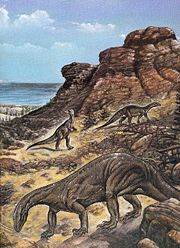
Like all prosauropods, Plateosaurus had forelimbs which were much shorter than the hindlimbs and they had distinct digits ('fingers') and a spiked 'thumb'. Plateosaurus has been traditionally depicted as quadrupedal, but a 2007 anatomical study of the forelimbs demonstrated that their range of motion precluded effective habitual quadrupedal gait. Like theropods, Plateosaurus and other related prosauropods could not rotate the hand so that their palms faced downward, and so would have been unable to use the front limbs for standing or walking. The study also ruled out the possibility of "knuckle-walking" and other forms of locomotion that would avoid the issue of the limited ability of Plateosaurus to pronate its hands. Thus, although its mass suggests a quadrupedal nature, it would have been restricted to its hind legs for locomotion. The forelimbs may have been used to rake trees for food, for grasping or for defense.
The hand bones of Plateosaurus were large, and bore five digits. The last two digits on each hand were very small.
Metabolism
A recent analysis of fossil deposits reveals there was considerable variation in size in individuals. Furthermore, growth rings in bone suggests periods of varying growth which may relate to the surrounding environment. Some plateosaurs reached their maximum size at twelve years old, while others were still growing after more than two decades. The size of adult specimens varies too; there are smaller specimens which when fully grown were four to six meters long, and others that measured up to ten meters long. Bone histology of Plateosaurus is well-preserved and studied. However, due to the absence of individuals smaller than 4.8 meters long, it is not possible to deduce an ontogenetic series for Plateosaurus. Like many other dinosaurs, Plateosaurus exhibits high growth rates, suggesting an advanced dinosaurian physiology. The paper's authors propose that the metabolism of Plateosaurus may have been intermediate between a reptilian and a warm-blooded one.
Popular culture
Plateosaurus was featured briefly in the opening sequence of The Land Before Time II: The Great Valley Adventure.
Plateosaurus featured briefly in the first episode (" New Blood") of the BBC television series Walking with Dinosaurs, to illustrate the success of dinosaurs.
Mounted Plateosaurus skeletons can be seen in the Institute and Museum for Geology and Paleontology, University of Tübingen, and the Humboldt Museum in Berlin, and the State Museum for Natural History in Stuttgart.
Plateosaurus is an adoptable animal in Zoo Tycoon: Dinosaur Digs.

